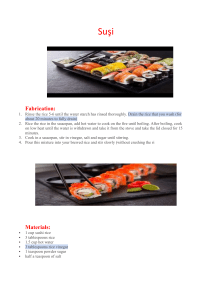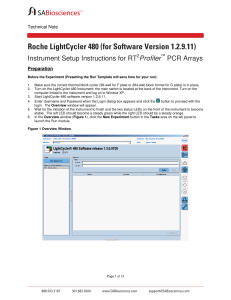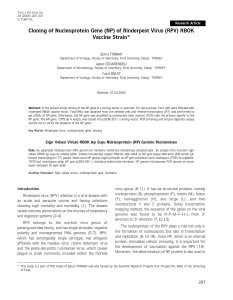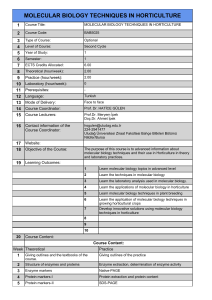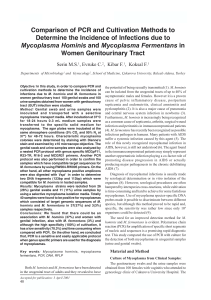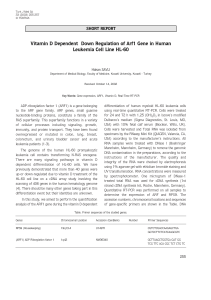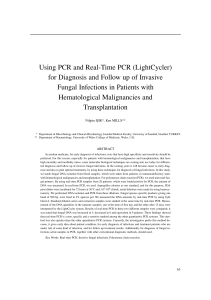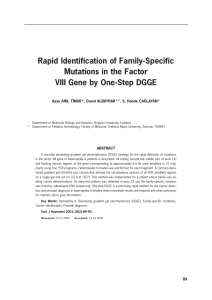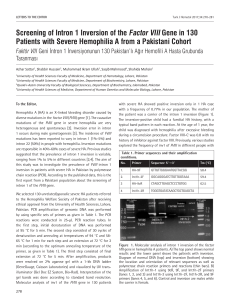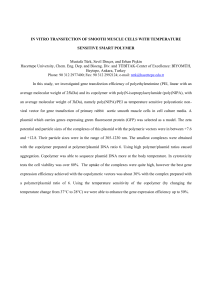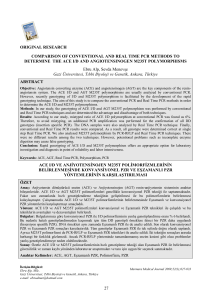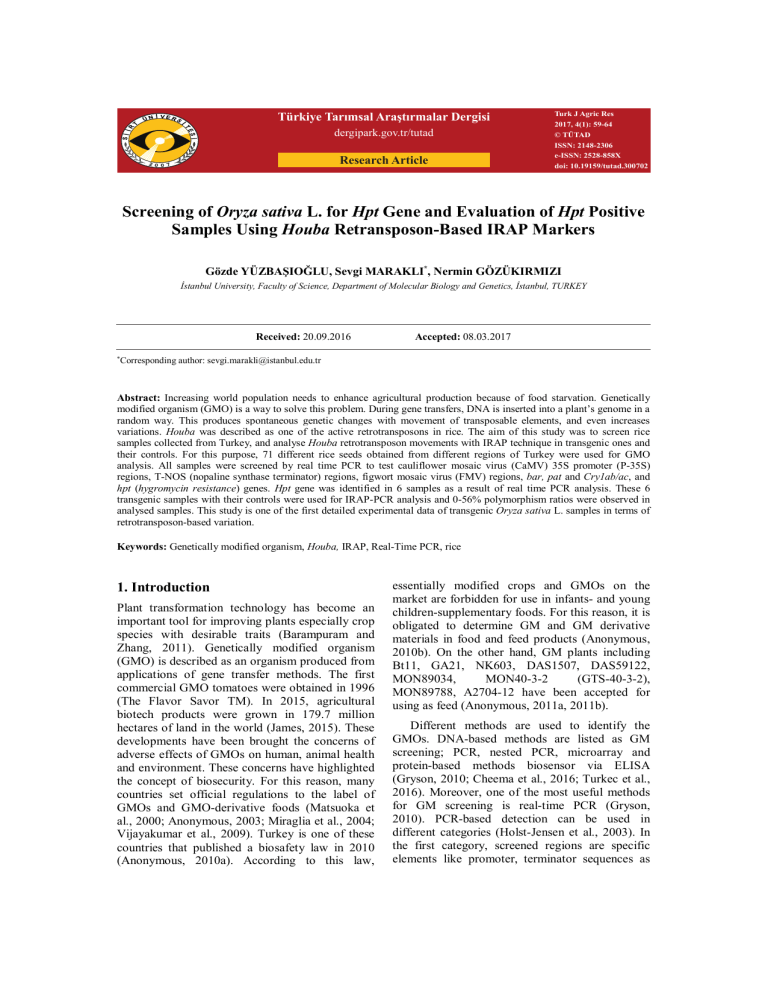
Türkiye Tarımsal Araştırmalar Dergisi
dergipark.gov.tr/tutad
Research Article
Turk J Agric Res
2017, 4(1): 59-64
© TÜTAD
ISSN: 2148-2306
e-ISSN: 2528-858X
doi: 10.19159/tutad.300702
Screening of Oryza sativa L. for Hpt Gene and Evaluation of Hpt Positive
Samples Using Houba Retransposon-Based IRAP Markers
Gözde YÜZBAŞIOĞLU, Sevgi MARAKLI*, Nermin GÖZÜKIRMIZI
İstanbul University, Faculty of Science, Department of Molecular Biology and Genetics, İstanbul, TURKEY
Received: 20.09.2016
*
Accepted: 08.03.2017
Corresponding author: [email protected]
Abstract: Increasing world population needs to enhance agricultural production because of food starvation. Genetically
modified organism (GMO) is a way to solve this problem. During gene transfers, DNA is inserted into a plant’s genome in a
random way. This produces spontaneous genetic changes with movement of transposable elements, and even increases
variations. Houba was described as one of the active retrotransposons in rice. The aim of this study was to screen rice
samples collected from Turkey, and analyse Houba retrotransposon movements with IRAP technique in transgenic ones and
their controls. For this purpose, 71 different rice seeds obtained from different regions of Turkey were used for GMO
analysis. All samples were screened by real time PCR to test cauliflower mosaic virus (CaMV) 35S promoter (P-35S)
regions, T-NOS (nopaline synthase terminator) regions, figwort mosaic virus (FMV) regions, bar, pat and Cry1ab/ac, and
hpt (hygromycin resistance) genes. Hpt gene was identified in 6 samples as a result of real time PCR analysis. These 6
transgenic samples with their controls were used for IRAP-PCR analysis and 0-56% polymorphism ratios were observed in
analysed samples. This study is one of the first detailed experimental data of transgenic Oryza sativa L. samples in terms of
retrotransposon-based variation.
Keywords: Genetically modified organism, Houba, IRAP, Real-Time PCR, rice
1. Introduction
Plant transformation technology has become an
important tool for improving plants especially crop
species with desirable traits (Barampuram and
Zhang, 2011). Genetically modified organism
(GMO) is described as an organism produced from
applications of gene transfer methods. The first
commercial GMO tomatoes were obtained in 1996
(The Flavor Savor TM). In 2015, agricultural
biotech products were grown in 179.7 million
hectares of land in the world (James, 2015). These
developments have been brought the concerns of
adverse effects of GMOs on human, animal health
and environment. These concerns have highlighted
the concept of biosecurity. For this reason, many
countries set official regulations to the label of
GMOs and GMO-derivative foods (Matsuoka et
al., 2000; Anonymous, 2003; Miraglia et al., 2004;
Vijayakumar et al., 2009). Turkey is one of these
countries that published a biosafety law in 2010
(Anonymous, 2010a). According to this law,
essentially modified crops and GMOs on the
market are forbidden for use in infants- and young
children-supplementary foods. For this reason, it is
obligated to determine GM and GM derivative
materials in food and feed products (Anonymous,
2010b). On the other hand, GM plants including
Bt11, GA21, NK603, DAS1507, DAS59122,
MON89034,
MON40-3-2
(GTS-40-3-2),
MON89788, A2704-12 have been accepted for
using as feed (Anonymous, 2011a, 2011b).
Different methods are used to identify the
GMOs. DNA-based methods are listed as GM
screening; PCR, nested PCR, microarray and
protein-based methods biosensor via ELISA
(Gryson, 2010; Cheema et al., 2016; Turkec et al.,
2016). Moreover, one of the most useful methods
for GM screening is real-time PCR (Gryson,
2010). PCR-based detection can be used in
different categories (Holst-Jensen et al., 2003). In
the first category, screened regions are specific
elements like promoter, terminator sequences as
YÜZBAŞIOĞLU et al.
CaMV, nopaline synthase terminator or genes
encoding the resistance to antibiotics used as
markers in selections. In the second category,
detection is carried out by identification of
specific-genes such as bar, pat and CryIA(b). In
category 3, junctions between promoter and genes,
and in category 4, junction between gene and its
integration locus are targeted for PCR
amplification. The last one is also called eventspecific which has been demonstrated in plants
such as rice, wheat, and maize (Barroso et al.,
2015; Zhang et al., 2015; Rao et al., 2016).
There are different DNA-based molecular
markers
to
analyse
genome
dynamics,
polymorphism, and even evolution in plants (Kaya
et al., 2013; Poczai et al., 2013; Cakmak et al.,
2015). The ubiquity, abundance, dispersion, and
dynamism
are
LTR
retrotransposons’
characteristics in plant genomes. Therefore, these
mobile elements are commonly studied as a
molecular marker (Kalendar and Schulman, 2006;
Poczai et al., 2013). IRAP (Inter-Retrotransposon
Amplified Polymorphism) is one of them. In this
method, PCR primers are designed as an outward
direction from the conserved sequences of LTR.
Therefore, internal regions between two LTRs or
solo LTRs (without retrotransposon) are amplified
(Kalendar et al., 1999). Transposons also cause
different phenotypes; for example, in 4,000
transposon-insertion lines detected, about 140 lines
showed a visible mutant phenotype (Kuromori et
al., 2006). The first step for successful variation
analysis with retrotransposons is to determine
plant-specific retrotransposons. Our group recently
described Houba retrotransposon as a good
variation analyser in rice (Yuzbasioglu et al.,
2016).
In this presented work, 71 rice samples were
collected from several markets and Trakya
Agricultural Research Institute in Turkey. CaMV
35S promoter regions, T-NOS regions, FMV
regions, bar, pat and Cry1ab/ac and hpt genes
were analysed to identify transgenics in all these
samples by real-time PCR. In addition, genetically
modified seeds with their non-transgenic controls
were compared with IRAP-PCR by using Houba
retrotransposon to determine variation.
2. Materials and Methods
2.1. Samples
71 rice samples were collected from different
regions in Turkey. GM rice samples used for
positive control were supplied from Assist. Prof.
Dr. A. Akbudak from Akdeniz University.
2.2. DNA extraction
Genomic DNAs were isolated from rice
samples according to Pervaiz et al. (2011)
protocol. The quantities of DNAs were measured
by Nanodrop (Thermo Scientific, 2000c) and
qualities were controlled in 1% agarose gel
electrophoresis.
2.3. GM detection
Primers and probes of hpt gene were designed
using GenBank (accession number K01193.1) and
GenScript Real-time PCR (TaqMan) primer design
programme
(https://www.genscript.com/ssl-bin/
app/primer). The nucleotide sequences of primers
and probes were shown in Table 1.
2.4. PCR conditions for GM analysis
PCR was carried out in a thermal cycler
(Agilent Mx300P). PCR assays were performed in
a final volume of 25 µl with 12.5 µl of PCR mix
and 7.5 µl Oligo mix and 100 ng of genomic DNA
for 35S, NOS, FMV, bar, pat and Cry1ab/ac
screening (Eurofins). In hpt PCR assays for
monitoring, the reaction mixture (25 µl) contained
12.5 µl of PCR master mix (Agilent
Technologies), 200 mM of each primer and probes
and 100 ng of genomic DNA. PCR conditions
were as follows: initial denaturation at 94◦C for 10
minutes, 45 cycles of denaturation at 95 ◦C for 15
seconds, annealing at 60◦ C for 1 minutes, for hpt
gene screening and 94◦C for 10 minutes, 45 cycles
of denaturation at 95◦C for 15 seconds, annealing
at 60◦ C for 1.5 minutes for 35S, NOS, FMV,
cry1ab/ac, bar and pat screening.
2.5. IRAP analysis
After GM detection, transgenic rice samples’
gDNAs were used for IRAP-PCR analysis to
investigate Houba retrotransposon movements.
Table 1. The Hpt gene primers’ and probe’s nucleotide sequences
60
Hpt R
5’- ATGCAAAGTGCCGATAAACA-3’
Hpt L
5-‘ATGTCCTGCGGGTAAATAGC-3’
Hpt P
5’-FAM- TGCGCCGATGGTTTCTACAAAGATC-TAMRA-3’
Türkiye Tarımsal Araştırmalar Dergisi - Turkish Journal of Agricultural Research
4(1): 59-64
YÜZBAŞIOĞLU et al.
Primer sequences designed by using IDT
(Integrated DNA Technologies) were shown in
Table 2. IRAP-PCR was performed in a total
volume of 20 µL, containing 20 ng template DNA,
10 nmol forward and reverse primers and
SapphireAmp Fast PCR Master Mix (Takara,
RR350A). Primer dimer or other contaminations
were checked by using no template control
(negative control). In this control, the PCR
contents were the same as in IRAP-PCR, but
without template (water was used instead of
template). The PCR conditions were as follows:
initial denaturation at 95 oC for 2.5 minutes,
followed by 30 cycles at 94 oC for 30 seconds, 51
o
C for 30 seconds, 72 oC for 2.5 minutes and the
reaction was completed with a cycle of final
extension at 72 oC for 7 minutes. The PCR
products were resolved in a 8% polyacrylamide
(29:1 Acrylamide:Bis) gel electrophoresis (BioRad, Protean II xi Cell) at 150 V for 8 h in 1X
TBE buffer (pH= 8.0). A molecular weight marker
(Thermo Scientific, SM0331) was also loaded to
determine the sizes of the PCR fragments. After,
the gel was visualised on UV transilluminator,
photographed and used for data analysis.
2.6. Data analysis
The well-resolved bands were scored as a
binary value, ‘1’ for presence and ‘0’ for absence
of bands. The binary matrix (1/0) was used to
calculate the similarity using Jaccard’s coefficient
(Jaccard, 1908).
Table 2. The Houba retrotransposon primer sequences used for IRAP analysis
Houba-F
5’-CTTCGAGTGGGCTAAGGCCC-3’
Houba-R
5’-GTTTCGACCAAGCAGCCGGTC-3’
3. Results
3.1. GM analysis
In this study, rice samples were investigated for
GM elements of 35S, NOS, FMV elements and
also bar, pat, cry1ab/ac and hpt. As a result of
analysis, no PCR amplification observed in 35S,
NOS, FMV and cry1ab/ac, bar and pat
experiments. On the other hand, we found that 6
samples of 71 rice seeds were transgenic because
of hpt gene amplification (Figure 1).
Figure 1. The Hpt gene real time amplification results. Orange line is positive control, other lines are samples
3.2. IRAP analysis
After determination of transgenic samples,
these seeds with non-transgenic controls were
analysed with IRAP marker to determine Houba
retrotransposition. Six samples (hygromycin
resistant), two control transgenic rice and two nontransgenic rice seeds were investigated using
Houba retrotransposon by IRAP-PCR (Figure 2).
Retrotransposon bands showed different
profiles among samples with the length between
Türkiye Tarımsal Araştırmalar Dergisi - Turkish Journal of Agricultural Research
4(1): 59-64
61
YÜZBAŞIOĞLU et al.
250 and 1500 bp. IRAP-PCR analysis showed that
there were polymorphic bands among samples.
Polymorphism rates were 0-56% among samples.
Moreover, polymorphism ratios were 0-25% for
between transgenic samples, 19% for control
transgenic rice and 19% for non-control transgenic
rice (Table 3).
4. Discussion
The impact of the insertion of DNA through
genetic engineering is probably paralleled by the
movement of transposable elements. Transposable
elements can be found in the genomes of all plants.
Rice genome project results showed that 35% of
rice genome is consist of transposons (TEs). IRAP
marker system can be a useful tool for
investigating rice breeding (Kalendar et al., 1999).
However, a retrotransposon based marker, like
IRAP, has not been used for the identification of
variation in transgenic rice until now.
Real time PCR is widely used for GMO
analysis to identify the presence of most
commonly integrated DNA elements in GMOs,
and also used event-specific methods provided by
the GMO developers (Broeders et al., 2012). In
Turkey, the screening process is carried out by
Real-Time PCR for only 35S, NOS, and FMV
genetic elements. However, there are so many GM
events that have different genetic elements rather
than 35S, NOS, and FMV. Moreover, hpt gene
provides resistance to aminoglycoside antibiotics
such as hygromycin B (Van den Elzen et al.,
1985). This antibiotic is much more effective than
kanamycin for the selection of transformed rice
tissues (Christou and Ford, 1995). Zuraida et al.
(2013) studied with hpt gene in Agrobacteriummediated genetic transformation of rice and
concluded that hygromycin B is a suitable
selection agent and selective marker for genetic
transformation. In addition to Agrobacteriummediated transformation, zinc finger nucleases
(ZFNs), transcription activator-like effector
nucleases (TALENs) and clustered regularly
interspaced
short
palindromic
repeats
(CRISPR)/CRISPR-associated
(Cas)
9
(CRISPR/Cas9) have been commonly used for
plant genome editing (Baltes and Voytas, 2015;
Figure 2. Houba retrotransposon variation analysis with IRAP-PCR
Transgenic rice: 1, 2, 3, 4, 5, 6. Control transgenic rice: 7, 8. Non-transgenic rice: 9, 10
Table 3. Polymorphism rates of Houba retrotransposon
1
2
3
4
5
6
7
8
9
10
1
-
2
19
-
3
19
24
-
4
20
25
13
-
5
20
25
13
0
-
6
13
25
19
7
7
-
7
44
40
46
54
50
50
-
8
50
52
56
54
54
50
19
-
9
7
24
24
29
25
19
40
56
-
10
13
29
53
35
31
29
40
50
19
-
Transgenic rice: 1, 2, 3, 4, 5, 6. Control transgenic rice: 7, 8. Non-transgenic rice: 9, 10
62
Türkiye Tarımsal Araştırmalar Dergisi - Turkish Journal of Agricultural Research
4(1): 59-64
YÜZBAŞIOĞLU et al.
Weeks et al., 2016). Especially CRISPR/Cas9
system has been used for genome editing in major
crops such as rice (Zhang et al., 2014; Xu et al.,
2015) maize (Feng et al., 2016) and wheat (Shan et
al., 2014).
In this study, 35S, NOS, FMV, elements and
bar, pat, cry1ab/ac genes were not detected but hpt
gene was found in 6 samples by using Real-Time
PCR analysis in total 71 rice seeds collected from
different sources. Results showed that the GMO
screening process could be modified to increase
screening range of genetic elements or genes in
Turkey. Houba retrotransposon movements in
transgenic rice with their controls were
investigated and 0-56% polymorphism ratios were
observed among all samples. In addition, we also
found that there were 0-25% for between
transgenic samples, 19% for control transgenic rice
and 19% for non-control transgenic rice.
In addition to important role of transposon in
genome structure and gene functions, information
about this issue is still at beginning level (Schnell
et al., 2015). In this study, effects of
transformation in GM rice on transposon
movements were investigated. For this purpose,
retrotransposon movements were compared in GM
rice and non-GM rice seeds by using Houba
retrotransposon specific IRAP-PCR. Results are
expected to contribute GMO screening by using
hpt gene and determination of transformation
results after gene transfers at molecular level.
Acknowledgements
This work was supported by Scientific Research
Projects Coordination Unit of Istanbul University.
Project numbers: 40028 and 20366.
References
Anonymous, 2003. Regulation (EC) No 1830/2003 of
the European Parliament and of the Council of 22
September 2003 concerning the traceability and
labeling of genetically modified organisms and the
traceability of food and feed products produced from
genetically modified organisms and amending
Directive2001/18/EC, Official Journal L, 268: 00240028.
Anonymous, 2010a. Turkish Republic Biosafety Law:
Law number 5977. Official Journal, 27533/Issue
date: 26.03.2010.
Anonymous, 2010b. Official Gazette of the Republic of
Turkey. Number: 27533. Biosafety Law.
Anonymous, 2011a. Official Gazette of the Republic of
Turkey. Number: 27827, Biosecurity Committee
Decisions, decision no.1, 2 and 3.
Anonymous, 2011b. Official Gazette of the Republic of
Turkey. Number: 28152, Biosecurity Committee
Decisions, Decision No. 4-16.
Baltes, N.J., Voytas, D.F., 2015. Enabling plant
synthetic biology through genome engineering.
Trends in Biotechnology, 33(2): 120-131.
Barampuram, S., Zhang, Z.J., 2011. Recent advances in
plant
transformation.
Plant
Chromosome
Engineering, pp. 1-35.
Barroso, M.F., Freitas, M., Oliveira, M.B.P.P., De-LosSantos-Alvarez, N., Lobo-Castanon, M.J., DeleureMatos, C., 2015. 3D-nanostructured Au electrodes
for the event-specific detection of MON810
transgenic maize. Talanta, 134: 158-164.
Broeders, S.R.M., De Keersmaecker, S.C.J., Roosens,
N.H., 2012. How to deal with the upcoming
challenges in GMO detection in food and feed.
Journal of Biomedicine and Biotechnology, 2012: 111.
Cakmak, B., Marakli, S., Gozukirmizi, N., 2015. SIRE1
retrotransposons in barley (Hordeum vulgare L.).
Russian Journal of Genetics, 51(7): 661-672.
Cheema, H.M.N., Khan, A.A., Khan, M.I., Aslam, U.,
Rana, I.A., Khan, I.A., 2016. Assessment of Bt
cotton genotypes for the Cry1Ac transgene and its
expression. The Journal of Agricultural Science,
154(1): 109-117.
Christou, P., Ford, T.L., 1995. The impact of selection
parameters on the phenotype and genotype of
transgenic rice callus and plants. Transgenic
Research, 4(1): 44-51.
Feng, C., Yuan, J., Wang, R., Liu, Y., Birchler, J.A.,
Han, F., 2016. Efficient targeted genome
modification in maize using CRISPR/Cas9 system.
Journal of Genetics and Genomics, 43(1): 37-43.
Gryson, N., 2010. Effect of food processing on plant
DNA degradation and PCR-based GMO analysis: a
review. Analytical and Bioanalytical Chemistry,
396(6): 2003-2022.
Holst-Jensen, A., Ronning, S.B., Lovseth, A., Berdal,
K.G., 2003. PCR technology forscreening
and
quantification of genetically modified organisms
(GMOs). Analytical and Bioanalytical Chemistry,
375(8): 985-993.
Jaccard, P., 1908. Nouvelles recherches sur la
distribution florale. Bulletin de la Societe Vaudoise
des Sciences Naturelles, 44(163): 223-270.
James, C., 2015. 20th Anniversary (1996 to 2015) of the
Global Commercialization of Biotech Crops and
Biotech Crop Highlights in 2015. ISAAA Brief No.
51, ISAAA: Ithaca, NY.
Kalendar, R., Grob, T., Regina, M., Suoniemi, A.,
Schulman, A., 1999. IRAP and REMAP: two new
retrotransposon-based
DNA
fingerprinting
techniques. Theoretical and Applied Genetics, 98(5):
704-711.
Kalendar, R., Schulman, A.H., 2006. IRAP and REMAP
for
retrotransposon-based
genotyping
and
fingerprinting. Nature Protocols, 1(5): 2478-2484.
Türkiye Tarımsal Araştırmalar Dergisi - Turkish Journal of Agricultural Research
4(1): 59-64
63
YÜZBAŞIOĞLU et al.
Kaya, Y., Yilmaz, S., Gozukirmizi, N., Huyop, F., 2013.
Evaluation of transgenic Nicotiana tabacum with
dehE gene using transposon based IRAP markers.
American Journal of Plant Sciences, 4(8A): 41-44.
Kuromori, T., Wada, T., Kamiya, A., Yuguchi, M.,
Yokouchi, T., Imura, Y., Takabe, H., Sakurai, T.,
Akiyama, K., Hirayama, T., Okada, K., Shinozaki,
K., 2006. A trial of phenome analysis using 4000
Ds-insertional mutants in gene-coding regions of
Arabidopsis. The Plant Journal, 47(4): 640-651.
Matsuoka, T., Kawashima, Y., Akiyama, H., Miura, H.,
Goda, Y., Kusakabe, Y., 2000. A method of
detecting recombinant DNAs from four lines of
genetically modified maize. Journal of the Hygienic
Society of Japan, 41(2): 137-143.
Miraglia, M., Berdal, K.G., Brera, C., Corbisier, P.,
Holst-Jensen,
A.,
Kok,
E.J.,
Marvin,
H.J.P., Schimmel, H., Rentsch, J., Van Rie, J.P.P.F.,
Zagon, J., 2004. Detection and traceability of
genetically modified organisms in the food
production chain. Food and Chemical Toxicology,
42(7): 1157-1180.
Pervaiz, Z.H., Turi, N.A., Khaliq, I., Rabbani, M.A.,
Malik, S.A., 2011. A modified method for highquality DNA extraction for molecular analysis in
cereal plants. Genetics and Molecular Research,
10(3): 1669-1673.
Poczai, P., Varga, I., Laos, M., Cseh, A., Bell, N.,
Valkonen, J.P.T., Hyvönen, J., 2013. Advances in
plant gene targeted and functional markers: a
review. Plant Methods, 9(6): 1-31.
Rao, J., Yang, L., Guo, J., Quan, S., Chen, G., Zhao, X.,
Zhang, D., Shi, J., 2016. Development of eventspecific qualitative and quantitative PCR detection
methods for the transgenic maize BVLA 430101 .
European Food Research and Technology, 242(8):
1277-1284.
Schnell, J., Steele, M., Bean, J., Neuspiel, M., Girard,
C., Dormann, N., Pearson, C., Savoie, A.,
Bourbanniere, L., Macdonald, P., 2015. A
comparative analysis of insertional effects in
genetically engineered plants: considerations for premarket assessments. Transgenic Research, 24(1): 117.
Shan, Q., Wang, Y., Li, J., Gao, C., 2014. Genome
editing in rice and wheat using the CRISPR/Cas
system. Nature Protocols, 9: 2395-2410.
64
Turkec, A., Lucas, S.J., Karacanli, B., Baykut, A.,
Yuksel, H., 2016. Assessment of a direct
hybridization microarray strategy for comprehensive
monitoring of genetically modified organisms
(GMOs). Food Chemistry, 194: 399-409.
Van den Elzen, P.J.M., Townsend, J., Lee, K.Y.,
Redbrook, J.R., 1985. A chimaeric hygromycin
resistance gene as a selectable marker in plant cells.
Plant Molecular Biology, 5(5): 299-302.
Vijayakumar, K.R., Martin, A., Gowda, L.R., Prakash,
V., 2009. Detection of genetically modified soya and
maize: Impact of heat processing. Food Chemistry,
117(3): 514-521.
Weeks, D.P., Spalding, M.H., Yang, B., 2016. Use of
designer nucleases for targeted gene and genome
editing in plants. Plant Biotechnology Journal,
14(2): 483-495.
Xu, R.F., Li, H., Qin, R.Y., Li, J., Qiu, C.H., Yang,
Y.C., Ma, H., Li, L., Wei, P.C., Yang, J.B., 2015.
Generation of inheritable and "transgene clean"
targeted genome-modified rice in later generations
using the CRISPR/Cas9 system. Scientific Reports,
5: 1-10.
Yuzbasioglu, G., Yilmaz, S., Marakli, S., Gozukirmizi,
N., 2016. Analysis of Hopi/Osr27 and
Houba/Tos5/Osr13 retrotransposons in rice.
Biotechnology & Biotechnological Equipment,
30(2): 213-218.
Zhang, H., Zhang, J., Wei, P., Zhang, B., Gou, F., Feng,
Z., Mo, Y., Yang, L., Zhang, H., Xu, N., 2014. The
CRISPR/Cas9 system produces specific and
homozygous targeted gene editing in rice in one
generation. Plant Biotechnology Journal, 12(6):
797-807.
Zhang, M., Yu, Y., Gao, X., Zhang, K., Luan, F., Zhu,
Y., Qu, B., 2015. Event-specific quantitative
detection of genetically modified wheat B72-8-11
based on the 3′ flanking sequence. European Food
Research and Technology, 240(4): 775-782.
Zuraida, A.R., Rahiniza, K., Zulkifli, A.S., Alizah, Z.,
Zamri, Z., Aziz, A., 2013. Hygromycin as selective
marker
in
Agrobacterium-mediated
genetic
transformation of indica rice MR 219 . Journal of
Tropical Agriculture and Food Science, 41(1): 7179.
Türkiye Tarımsal Araştırmalar Dergisi - Turkish Journal of Agricultural Research
4(1): 59-64

